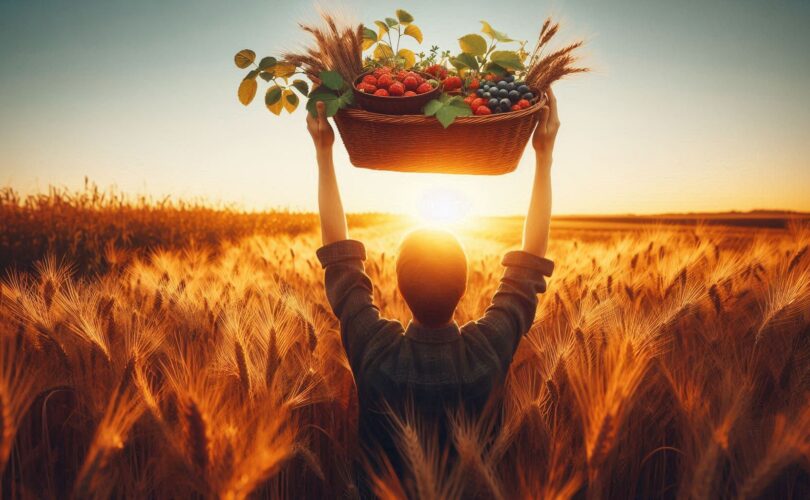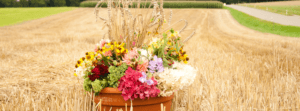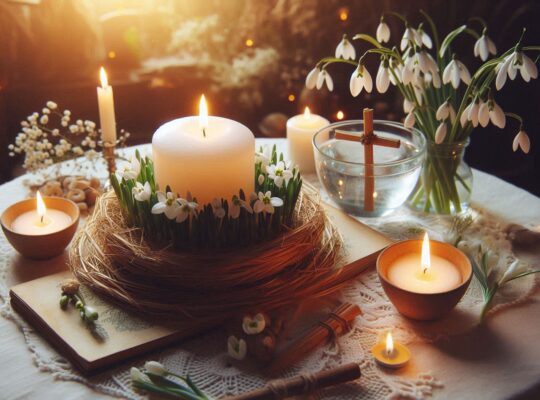Lughnasadh’s Abundant Healing: Celebrating the First Harvest
As summer’s warmth begins to gently shift and golden fields sway with ripening grain, the Wheel of the Year turns to welcome Lughnasadh, the first harvest celebration. During this special time, we honor the earth’s growing abundance and the fruits of our own efforts. Lughnasadh (pronounced “LOO-nah-sah”) reminds us that growth requires both patient tending and joyful celebration when our work begins to bear fruit. In this guide, we’ll explore simple ways to bring Lughnasadh’s nurturing energy into your life with healing rituals that connect you to the cycle of growth, harvest, and gratitude.
When Lughnasadh’s Harvest Begins
Lughnasadh arrives on August 1st each year in the Northern Hemisphere. In 2025, we’ll celebrate on Friday, August 1st. This joyful holiday marks the midpoint between the Summer Solstice (Litha) and the Fall Equinox (Mabon), when the first fruits and grains are ready for harvest.
After Litha’s peak sunlight in June, Lughnasadh brings the first signs that summer is beginning its gradual transition toward autumn. The days remain warm but grow slightly shorter, and the earliest crops stand ready for gathering. Traditional celebrations honored this time with harvest rituals, community feasts, and games of skill and strength.
The name “Lughnasadh” comes from ancient Celtic traditions honoring Lugh, a skilled god associated with light, craftsmanship, and the arts. Legend tells that Lugh created this festival to honor his foster mother Tailtiu, who cleared the lands of Ireland for agriculture before dying from her efforts. This reminds us that our harvests often come through both our own work and the support of those who came before us.
Lughnasadh celebrates the perfect balance of human effort and nature’s gifts – the way our tending and care work in partnership with sun, soil, and rain to create abundance. This makes it an ideal time for gratitude practices that acknowledge both our efforts and the greater forces that support our growth.
Ancient Wisdom of Lughnasadh
For thousands of years, people have celebrated the first harvest with rituals of thanksgiving and community gathering. Our ancestors understood that this moment marked an important transition – when the promise of spring’s planting began to fulfill itself in summer’s abundance.
In Celtic traditions, Lughnasadh (also called Lammas in some regions) was a time for harvest fairs, athletic competitions, handfasting ceremonies, and the baking of bread from the first grains. Communities would gather on hilltops to collect berries, perform rituals, and create bonds that would help them through the coming winter months.
The cutting of the first grain was treated as a sacred act, often accompanied by specific harvest songs and prayers that honored the spirit of the grain. In some traditions, the last sheaf cut from the field was fashioned into a figure called the “corn dolly,” which represented the spirit of the harvest that would be preserved until spring planting.
When we celebrate Lughnasadh today, we join this long line of people who have paused to give thanks for abundance and acknowledge the cycle of growth. Their simple wisdom teaches us that taking time to celebrate our accomplishments, no matter how small, nourishes both our bodies and spirits for the work that still lies ahead.
Lughnasadh’s Special Symbols
Lughnasadh gives us meaningful symbols that connect us to the season’s healing energy. Grain represents the basic nourishment that sustains life, reminding us to appreciate simple blessings and recognize what truly nourishes us on our journey. Whether wheat, barley, corn, or oats, the golden stalks represent the culmination of a growth cycle that began with tiny seeds.
Bread becomes a powerful Lughnasadh symbol, embodying the transformation of raw grain into sustaining food through human skill and the elements of fire, water, air, and earth working together. The aroma of fresh-baked bread connects us to kitchens throughout history where similar scents have brought comfort and satisfaction.
Berries reach their peak ripeness now, offering their sweet rewards after months of growth. Blackberries, blueberries, and other summer fruits remind us that life’s sweetness often comes with effort – reaching through thorns or climbing to pick the perfectly ripe berry teaches us that some of our most delicious rewards require us to overcome challenges.
The sun remains strong at Lughnasadh, though its power has begun to wane slightly from the solstice peak. This reminds us that even as we celebrate abundance, we acknowledge the natural cycle that includes both growth and decline, encouraging us to appreciate the present moment’s gifts.
Simple Lughnasadh Rituals for Healing
Baking bread offers a beautiful Lughnasadh ritual that connects you to generations of harvest celebrations. Even if you’ve never baked bread before, simple recipes make this accessible to everyone. As you mix the ingredients, focus on blending the elements – earth (grain), water, air (rising), and fire (baking) – just as we need all elements for wholeness in our lives. While kneading the dough, pour your gratitude for recent blessings into this creative act, and when sharing the bread, know you’re participating in one of humanity’s oldest communion rituals.
Create a gratitude jar to honor the first harvest of your year’s efforts. Decorate a jar with symbols of abundance like wheat, cornucopia, or sun images. Each day during the Lughnasadh season, write one thing you’re grateful for on a small slip of paper and place it in the jar. By Mabon (the Fall Equinox), you’ll have your own personal harvest of blessings to reflect upon.
A sunrise grain blessing connects you to traditional Lughnasadh practices. Rise early on August 1st (or the closest morning possible) and bring a handful of grain or seeds outdoors. As the sun rises, hold the grain up to catch the first light, then sprinkle it on the earth as an offering while expressing gratitude for the abundance in your life. This simple ritual acknowledges both the sun’s role in growth and our connection to the earth’s cycles.
The Lughnasadh skill-sharing ritual honors Lugh’s mastery of many crafts. Identify a skill you possess – perhaps cooking, crafting, gardening, writing, or listening well – and share it with someone else through teaching, demonstrating, or creating something for them. This honors your own gifts while creating connection through sharing, reflecting the community aspect of traditional harvest celebrations.
Healing Plants of Lughnasadh
As summer reaches its abundant peak, certain plants offer special healing benefits:
- Sunflowers stand tall at Lughnasadh, their bright faces following the sun across the sky. These magnificent plants teach us about resilience, optimism, and staying connected to our source of energy. Sunflower seeds provide nourishing food, while the flowers themselves bring joy through their dramatic beauty. Keeping sunflowers on your altar or in your home reminds you to turn toward light and positivity.
- Calendula (pot marigold) blooms golden in summer gardens, offering powerful skin-healing properties. The cheerful flowers can be infused in oil for salves that soothe summer-burned skin or dried for teas that support digestion. Calendula’s association with the sun makes it perfect for Lughnasadh celebrations of light and growth.
- Blackberry bushes ripen their fruits along summer paths, offering sweet-tart berries alongside protective thorns. This plant teaches the balance of abundance and boundaries – that we can offer our sweetness to the world while still protecting our essential selves. The leaves make a gentle astringent tea that soothes sore throats and settles digestion, while the berries themselves are packed with antioxidants.
- Yarrow grows abundantly in summer fields, its feathery leaves and white flower clusters offering powerful medicine. Traditionally used to stop bleeding (it was carried on battlefields), yarrow teaches us about healing wounds and establishing healthy boundaries. A tea of yarrow flowers brings down fevers and supports the body’s natural healing processes.
- Mint reaches its fragrant peak now, offering cooling relief for summer’s heat. This abundant plant teaches us about growth and resilience (sometimes too much so in gardens!), while providing digestive support and refreshment. Crushing a few mint leaves in cool water creates an instant summer refreshment that connects you to the plant’s generous healing energy.
Creating Your Lughnasadh Altar
Your Lughnasadh altar becomes a focal point for harvest energies – a sacred space where gratitude concentrates and healing abundance gathers. Create this space with joyful presence, letting your heart guide what feels right.
Fresh flowers bring living beauty – sunflowers, black-eyed Susans, and other yellow or golden blooms especially honor the sun’s role in ripening the harvest. Arrange them in a vase of water with a drop of orange or cinnamon essential oil to amplify the warmth of the season.
Candles in gold, yellow, orange or brown represent Lughnasadh’s fire and earth connection. As you light each one, speak a blessing of gratitude for something that has “ripened” in your life. Yellow candles symbolize the sun’s continued strength; orange represents creativity and joy; brown honors the earth from which all growth comes.
Add symbols of the harvest – perhaps a small sheaf of wheat or other grain stalks, fresh bread, ripe fruits, or corn dolls made from dried husks or grasses. If you’ve grown any food yourself, include some as a special acknowledgment of your personal harvest.
Crystals that support Lughnasadh’s energy include citrine for abundance and joy, tiger’s eye for grounding and practical manifestation, and carnelian for creativity and vitality. Place these stones in sunlight before adding them to your altar.
Images or items representing skills you’ve developed or goals you’ve accomplished make powerful additions. Unlike winter’s inward focus on potential, Lughnasadh celebrates what has already manifested through your efforts.
Let your altar evolve throughout the Lughnasadh season, perhaps adding grain or flowers from your walks, or symbols of new accomplishments as they occur. This sacred space honors both the outer turning of the Wheel and your inner journey toward wholeness and healing.
Foods for Lughnasadh Celebration
Lughnasadh is the perfect time to enjoy the seasonal abundance of summer’s harvest. Fresh vegetables from your garden or local farmers’ market – tomatoes, zucchini, peppers, and corn – connect you directly to the earth’s generosity. Creating a meal that features these fresh ingredients honors the season’s gifts while providing vibrant nutrition.
Bread holds special importance at Lughnasadh as the most basic and ancient transformation of grain into nourishment. If baking your own isn’t possible, purchasing a special loaf from a local bakery still honors this tradition. Breaking bread with loved ones creates sacred community, whether through an elaborate feast or a simple meal shared with intention.
Berries reach their perfect ripeness now, offering their sweet medicine as summer’s special gift. Create a simple berry dessert, perhaps topped with honey or cream, to celebrate this seasonal abundance. Taking time to gather berries yourself – whether from your garden, a pick-your-own farm, or wild bushes (where permitted) – adds another layer of connection to this practice.
Corn represents abundance in many traditions, and often becomes available around Lughnasadh. Enjoying fresh corn on the cob connects you to indigenous wisdom that has honored this important grain for centuries. Save a few husks for crafting traditional corn dollies if this practice calls to you.
Fresh herbs add flavor and healing properties to Lughnasadh meals. Basil, oregano, thyme, and rosemary reach their aromatic peak now, offering their oils and essences most generously. Adding these to your cooking brings the medicine of the garden directly to your table.
Approach cooking as a sacred act – a way to bring nature’s healing energy into your body. Let each bite connect you to Lughnasadh’s celebration of abundance, craft, and the satisfaction of enjoying what you’ve helped to create or tend.
Divine Guides of Lughnasadh
The spiritual beings connected to Lughnasadh can support your seasonal journey. Think of them as helpful energies rather than distant figures – aspects of wisdom that you can connect with through intention and awareness.
Lugh himself, the skilled Celtic god who gives this festival its name, represents mastery of crafts, creative expression, and honoring our unique gifts. His many talents remind us that we too contain multiple abilities and strengths. Call on his energy when developing new skills, honoring your accomplishments, or seeking to express yourself authentically.
The Grain Mother, known by many names across cultures (Demeter in Greece, Ceres in Rome, John Barleycorn in British folklore), represents the living spirit of the harvest. She embodies nurturing abundance and the cycle of plant life that sustains us. Connect with her energy when seeking nourishment – physical, emotional, or spiritual – or when honoring the cycles of giving and receiving in your life.
Tailtiu, Lugh’s foster mother in Irish mythology, represents self-sacrifice for community good and the hard work that precedes harvest. Her story reminds us that our current abundance often comes from others’ efforts. Honor her energy when acknowledging those who have supported your growth or when you contribute your own effort toward collective wellbeing.
Earth goddesses like Gaia (Greek) or Danu (Celtic) embody the living planet that provides all sustenance. Their energy reminds us of our place within natural systems and our responsibility to give back to the earth that feeds us. Connect with them when seeking to deepen your relationship with the natural world or when making choices that affect environmental wellbeing.
These divine energies exist both in the world around us and within our own consciousness. They don’t require elaborate rituals – just an open heart and willingness to recognize their qualities in nature and within yourself.
Community Healing at Lughnasadh
Lughnasadh traditionally brings people together to celebrate the first fruits of harvest and share in communal abundance. This social aspect reminds us that true wealth comes through connection and mutual support rather than individual accumulation.
Consider hosting a small harvest potluck where everyone brings a dish featuring seasonal ingredients. This creates a feast that honors summer’s bounty while strengthening community bonds. The shared meal becomes more than physical nourishment – it feeds our human need for connection and celebration.
Skill-sharing workshops honor Lughnasadh’s association with Lugh’s many talents. Organize a gathering where people teach each other practical skills – perhaps bread baking, herb identification, preserving food, crafting, or sharing knowledge about sustainable living. These exchanges build community resilience while honoring each person’s unique gifts.
Food donation drives align perfectly with Lughnasadh’s energy. After appreciating your own abundance, consider organizing or contributing to efforts that share food with those experiencing scarcity. Many food banks experience shortages during late summer, making this a particularly meaningful time to share the harvest’s bounty.
Nature cleanup projects combine celebration with service. Gathering friends to tend a community garden, clear a hiking trail, or clean a local waterway honors our responsibility to care for the earth that provides our food. Even small actions create ripples of positive impact that extend beyond individual benefit.
Through these connections, we embody Lughnasadh’s medicine of abundance and gratitude. We remember that healing flourishes in community – with each other, with the earth, and with the cycles that sustain all life.
Journal Writing for Lughnasadh Growth
Writing in a journal helps us process our personal harvests and set intentions for continued growth. Find a quiet moment in a garden or near a window where you can see growing things, light a candle representing Lughnasadh’s warmth, and explore these questions:
- What have you harvested in your life since spring? Consider both outer accomplishments and inner growth – skills developed, challenges overcome, relationships nurtured, or insights gained. Acknowledge these fruits of your efforts with genuine appreciation for how far you’ve come.
- Where do you see evidence of abundance in your life? Look beyond material wealth to recognize richness in experience, knowledge, relationships, creativity, or spiritual connection. Noting these forms of abundance trains your awareness to recognize fullness rather than scarcity.
- What seeds planted earlier this year are still developing? Not everything grows at the same rate – some intentions need more time to fully manifest. How might you continue tending these growing possibilities with patience and care?
- What has required hard work or sacrifice to bring to fruition? Lughnasadh honors both the joy of harvest and the effort that precedes it. Acknowledging challenges you’ve navigated honors your resilience and determination.
- How have others contributed to your growth and achievements? Like farmers who depend on community for successful harvests, our accomplishments rarely happen in isolation. Who has supported, taught, inspired, or assisted you on your journey?
- What feels ready to be released or composted in your life? Just as farmers clear fields after harvest, consider what completed projects, outgrown patterns, or fulfilled goals might now be released to make space for new growth.
Before writing, you might hold a piece of bread or grain in your hands, feeling its nourishing essence while acknowledging your own capacity to both receive and offer sustenance. Just as bread requires many ingredients and processes to transform from seed to food, your journey combines many elements into something greater than the sum of its parts.
Tarot Cards for Lughnasadh Insight
Tarot cards offer helpful insights during harvest season, reflecting both what we’ve cultivated and what we might create next. These card spreads act as mirrors showing the fruits of past efforts and the seeds of future abundance.
The Harvest Wisdom Spread helps identify your current season of growth. Find a quiet space outdoors if possible, or near a window with a view of growing things. Take three deep breaths, connecting to both earth below and sky above.
Draw your first card asking: “What am I harvesting in my life right now?” This card shows what’s coming to fruition through your efforts – perhaps in your work, relationships, creative endeavors, or personal development.
Your second card answers: “How can I best appreciate and utilize this abundance?” This card offers guidance about honoring your achievements and making the most of what you’ve cultivated.
The third card reveals: “What requires further tending or patience?” Not everything ripens simultaneously. This card shows areas still developing that need continued care and attention.
Your final card provides wisdom by answering: “What seeds should I plant now for future harvests?” This card offers insight about new beginnings that align with your authentic path and the season ahead.
After completing your reading, sit quietly with the insights revealed. Rather than rushing to action, let the wisdom settle like grain after threshing. Perhaps place a significant card on your Lughnasadh altar as a reminder of your journey’s current phase.
Celebrating the First Harvest: A Simple Lughnasadh Ritual
As Lughnasadh approaches, prepare for a ritual that honors the first harvest and your own accomplishments. This ceremony creates space to express gratitude, acknowledge growth, and set intentions for the continuing cycle.
Gather these items: a candle in gold, yellow or orange; bread (homemade or purchased with intention); fresh fruits or vegetables from the summer harvest; a small bowl of water; flowers or herbs from your garden or local area; and something representing a skill you’ve developed or goal you’ve achieved.
Create sacred space through cleansing – perhaps by burning herbs like sage or rosemary, ringing a bell, or simply visualizing golden light filling your space and clearing any heavy energy. Arrange your materials somewhere special where you feel connected to both earth and sky.
Begin your ceremony by sitting or standing quietly, holding the bread between your hands. Feel its substance and weight, connecting to both the earth’s generosity that grew the grain and human craft that transformed it into food. Acknowledge the many hands that contributed to bringing this nourishment to you.
Light your candle, speaking words that honor the harvest energy: “I welcome Lughnasadh’s abundance and light. May it nourish my body, illuminate my path, and remind me to celebrate life’s gifts.” Pause to watch the flame, allowing its warmth to remind you of the sun’s role in all growth.
Place your fruits, vegetables, flowers or herbs around the candle, creating a display of summer’s bounty. Touch each item with gratitude, recognizing it as a gift from the earth and sun’s partnership.
Now take a moment to acknowledge your own harvests. Hold the object that represents your skill or achievement, speaking aloud what you’ve accomplished or developed since spring. Remember the efforts, challenges, learning, and growth involved in this personal harvest.
Break the bread (rather than cutting it) and dip a piece into the bowl of water. This ancient gesture honors the partnership of earth (grain) and water that creates sustenance. Before eating the bread, speak words of gratitude for specific blessings in your life.
Close your ritual by expressing thanks for the earth’s abundance, the wisdom of seasonal cycles, and your own capacity to both create and receive. Place any remaining bread outdoors for birds or other creatures, extending the circle of sharing.
In the days following, notice moments of abundance and achievement that might previously have gone unrecognized. Lughnasadh teaches us to celebrate not just dramatic accomplishments but also the steady, reliable harvests that sustain us day by day.
Embracing Lughnasadh’s Abundant Healing
As the wheel turns to Lughnasadh, we’re invited to pause in summer’s golden moment – to acknowledge what has grown, to celebrate first fruits, and to share our abundance with others. This threshold between peak summer and early autumn reminds us that life moves in cycles of planting, tending, harvesting, and rest.
The ripening fields and fruit-laden trees show us the beauty of fulfillment – the satisfaction that comes when patient care results in tangible rewards. We too can honor our own growth cycles, recognizing that meaningful achievement usually follows consistent effort rather than overnight transformation.
Lughnasadh whispers to us about the healing that comes from balancing work with celebration. In a world that often values constant productivity, this festival reminds us to pause and enjoy what we’ve already created before rushing toward the next goal. The wisdom of our ancestors teaches that taking time to feast, play, and give thanks actually renews our energy for the work still ahead.
The early harvest reminds us that abundance itself is a cycle – neither permanent nor scarce, but flowing through seasons of more and less. By celebrating first fruits while knowing more growth continues, we learn to appreciate what’s available now while trusting in future harvests.
As you celebrate this special turning point, may you recognize the many ways you’ve grown and the gifts your efforts have yielded. May you find joy in sharing your unique skills and abundance with others. May you remember that you are part of nature’s great cycle – not separate from the turning seasons but a vital, creative participant in life’s continuing unfoldment.
The promise of Lughnasadh is that our efforts do bear fruit, though not always in the ways or timelines we expect. Like farmers who learn to work with weather and soil conditions beyond their control, we grow resilient by balancing what we can influence with acceptance of what we cannot.
Blessed Lughnasadh. May your celebrations be joyful, your harvests abundant, and your heart open to summer’s golden gifts.








